Virtual shifting is arguably the biggest innovation Zwift has brought to the indoor cycling scene in recent years.
What’s so great about it, how does it work, and what hardware is required? Let’s dive in…
Virtual Shifting Basics
Unless you ride a single-speed bike, you’re using physical gears to make your riding more enjoyable. You’ll typically shift to an easier (lower) gear when riding uphill so you aren’t grinding away, and you may shift to a higher gear on a descent so you don’t spin out.
With virtual shifting, your chain doesn’t move between different front chainrings or rear cassette cogs when you shift. Instead, when you make a virtual shift, the resistance of your smart trainer changes so it feels like you’ve changed gears.

Virtual Shifting Benefits
Why do Zwifters like virtual shifting? Because it beats mechanical shifting in many ways:
- Smooth and quiet: with no chains skipping between cogs, your shifts are completely silent, perfectly smooth, and fast.
- Reduced drivetrain wear: your chain won’t wear out as quickly, and neither will your chainrings or cassette, since you’re reducing the damaging stresses of shifting.
- Shift under full load: no need to ease off the pedals when shifting under big power, as your chain isn’t going to “skip” with virtual shifting like it can with mechanical shifting.
- Shift under zero load: have you ever stopped riding, especially on a climb, then found it really hard to get going again because you’re in the wrong gear? With virtual shifting, you can shift to an easier gear without pedaling.
- Compatible across many bikes: no more spinning out on your low-geared mountain bike, or wanting to swap trainer cassettes when you swap bikes. Virtual shifting works with almost any 8-12 speed bike and auto-calibrates to your physical gearing (more on this below).
- Expanded gear range: Zwift’s virtual shifting currently supports a virtual 24-speed setup, which is more gears than most riders have on their outdoor setups. Additionally, the gear ratio range is very wide (from .75 to 5.49), meaning virtual shifting offers more high and low gears than your mechanical setup.
- In-game visualization: with Zwift’s virtual shifting, you can always see what gear you’re in on screen.
- No more fine-tuning: many riders have to adjust their physical shifting when moving between outdoor and indoor riding, since the cassette on their trainer isn’t positioned exactly like the cassette on their rear wheel. If you’re using the Zwift Cog (see below) you don’t need to do any such fine-tuning… just shift to a physical gear that has your chain lined up straight on the Cog and you’re ready to ride.
In-Game Usage and Settings
Watch a quick video showing how Zwift’s virtual shifting works in game using the Play or Click controllers:
This video is a bit outdated here in 2025, but it gives you a basic idea of how virtual shifting works in game, so we’ve included it here…
Virtual Shifting Hardware: Smart Trainers
Thanks to the popularity of Zwift’s virtual shifting, basically all new trainer models since 2024 have supported it, and some companies have updated firmware for older trainers to roll out virtual shifting support.
Currently, the following smart trainer models support virtual shifting:
- Elite Avanti
- Elite Avanti with Zwift Cog and Click
- Elite Direto
- Elite Direto X
- Elite Direto XR
- Elite Direto XR with Zwift Cog and Click
- Elite Direto XR-T
- Elite Justo
- Elite Justo 2
- Elite Rivo
- Elite Rivo with Zwift Cog and Click
- Elite Suito
- Elite Suito T
- JetBlack Victory
- JetBlack Volt V2
- Tacx NEO 2
- Tacx NEO 2T
- Tacx NEO 3M
- VAN RYSEL D100
- Wahoo KICKR CORE
- Wahoo KICKR CORE 2
- Wahoo KICKR CORE Zwift One
- Wahoo KICKR Gen 6 (2022)
- Wahoo KICKR Move
- Zwift Hub Classic
- Zwift Hub One
Note: you must connect your trainer via Bluetooth, WiFi, or a direct ethernet connection in order to use Zwift’s virtual shifting. It is not supported over ANT+.
Virtual Shifting Hardware: Play vs Ride vs Click
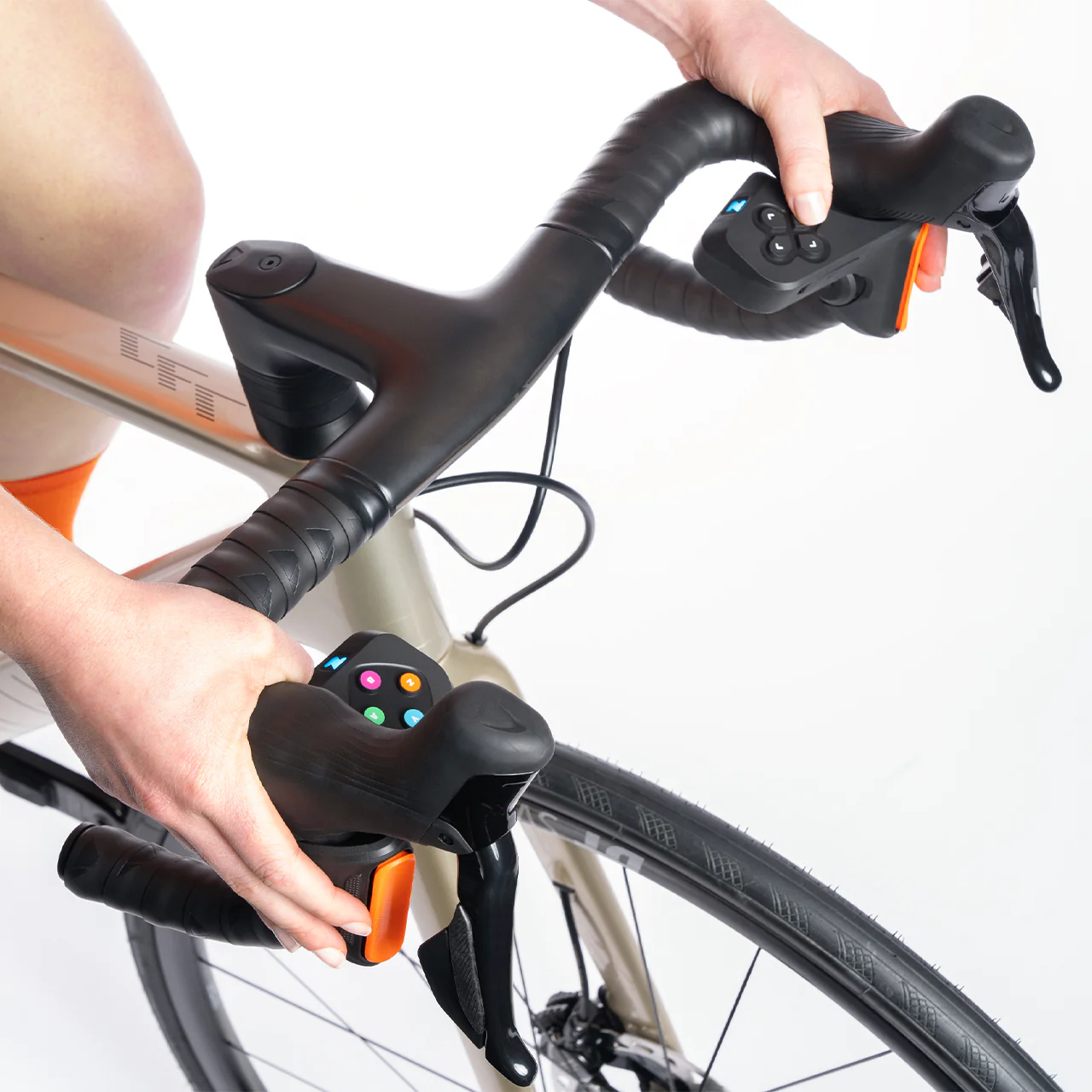
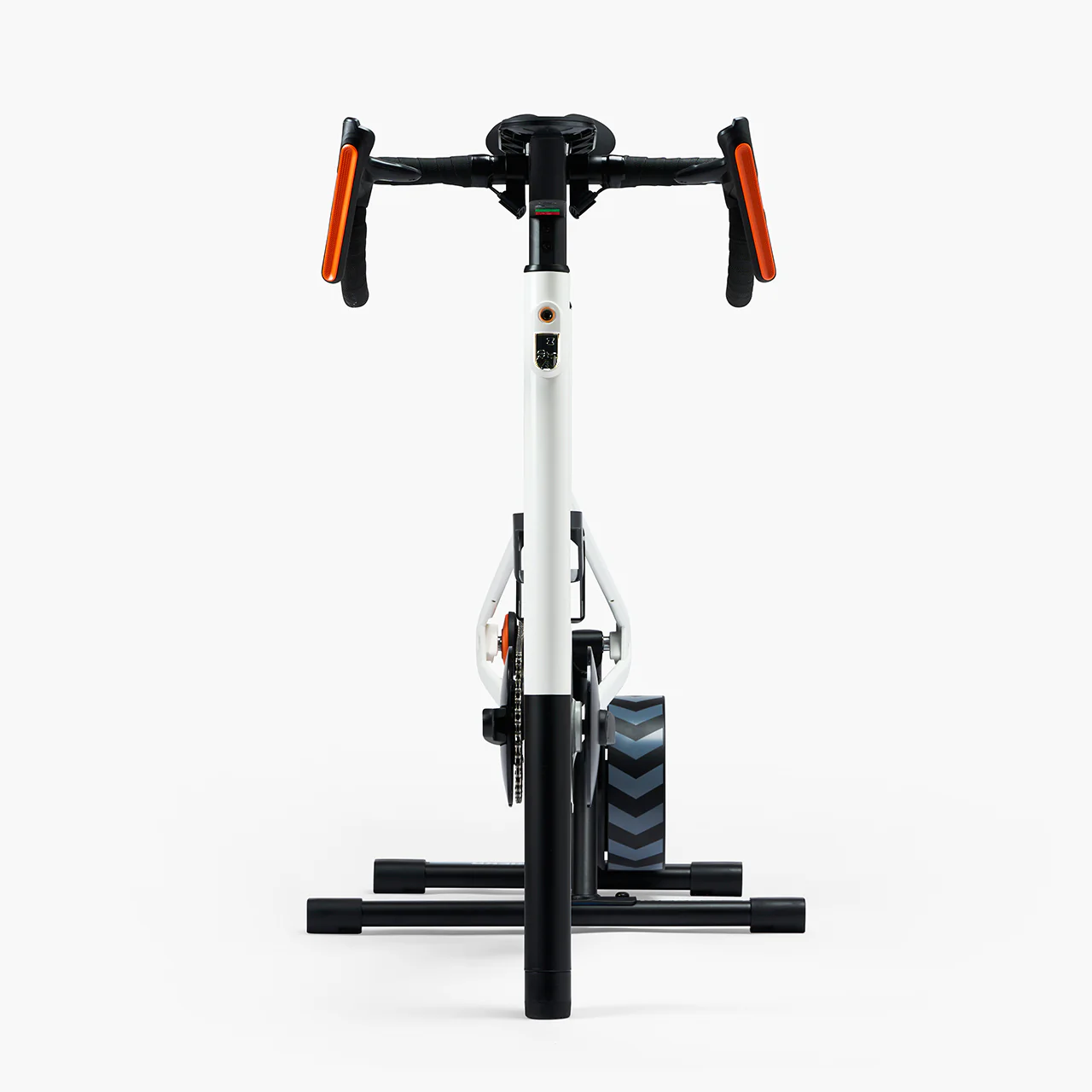
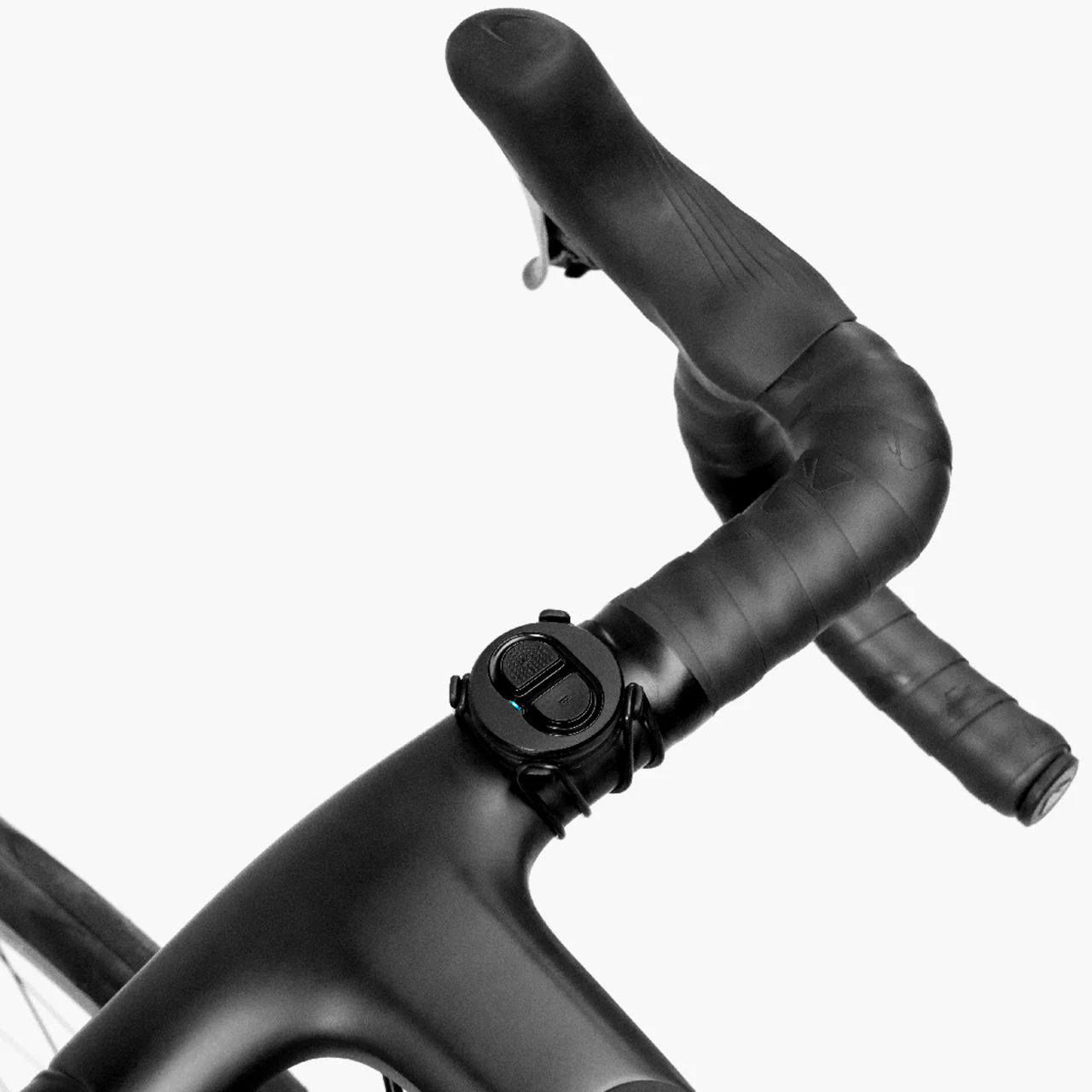
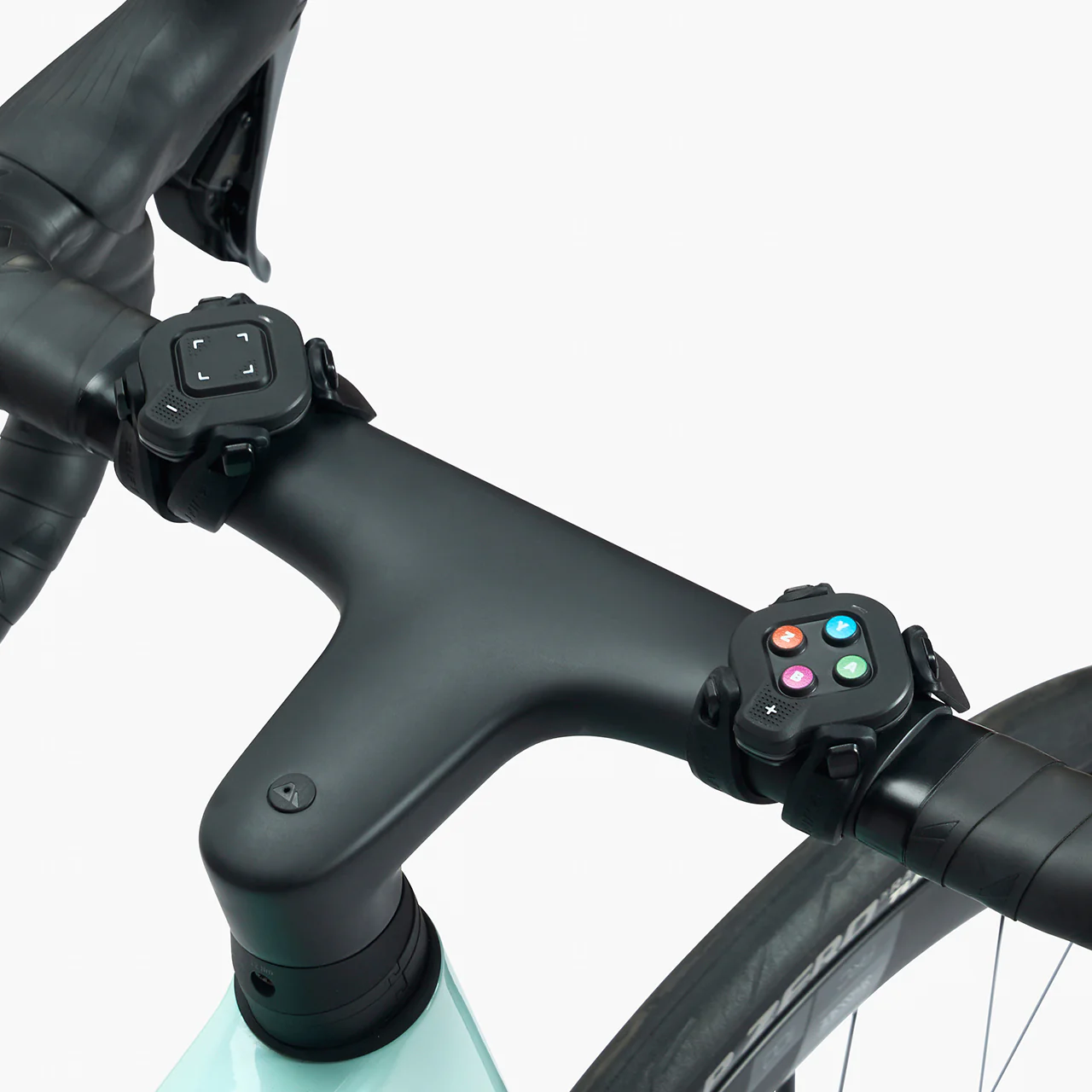
Interested in getting virtual shifting, but aren’t sure if you should buy the affordable Click v2, get a whole Zwift Ride Smart Bike, or something else? Here’s a rundown of features and specs for all the virtual shifting hardware Zwift has ever made:
| Play | Ride | Click | Click v2 | |
| Virtual Shifting | ✅ | ✅ | ✅ | ✅ |
| Steering | ✅ | ✅ | ❌ | ✅ |
| Braking | ✅ | ✅ | ❌ | ❌ |
| Powerup Trigger | ✅ | ✅ | ❌ | ✅ |
| Ride On Bomb button | ✅ | ✅ | ❌ | ✅ |
| Game Navigation buttons | ✅ | ✅ | ❌ | ✅ |
| Drop bar compatible | ✅ | ✅ | ✅ | ✅ |
| Flat bar compatible | ❌ | n/a | ✅ | ✅ |
| TT bar compatible | ❌ | n/a | ✅ | ✅ |
| Sequential Shifting | ✅ | ✅ | ✅ | ✅ |
| SRAM-Style Shifting | ✅ | ✅ | ✅ | ✅ |
| Shimano-Style Shifting | ❌ | ✅ | ❌ | ❌ |
| Cog Included | ❌ | ✅ | ✅ | ✅ |
| Power Source | USB Rechargeable | USB Rechargeable | Coin cell (CR2032) | Coin cell (CR2032) |
| Battery Life | ~20 hours | ~20 hours | >100 hours | >100 hours |
| BLE Connections* | 2 | 1 | 1 | 1 |
| Price | Discontinued | $1300 (frame + trainer) or $800 (frame only) | Discontinued | $50US |
*If you’re an Apple TV user, it’s worth noting that the Click and Ride controllers use just one Bluetooth connection, while Play requires two. Apple TV limits users to two Bluetooth connections, which means Play users on Apple TV must pair all devices through the Companion app (since you must also connect your smart trainer, which would make three connections if you add Play into the mix). The only way around this is via a smart trainer that can connect using WiFi (read more).
But if you use Click or Ride, you may still be able to pair directly through Apple TV, as long as you aren’t pairing a heart rate monitor as a separate device.
Virtual Shifting Hardware: Zwift Cog
First released in October 2023, the Zwift Cog is a single-cog replacement for a standard rear cassette. It was initially sold with the Zwift Hub One smart trainer, and the latest version is now sold with various trainers, the Zwift Ride, and as a package with the Click v2.
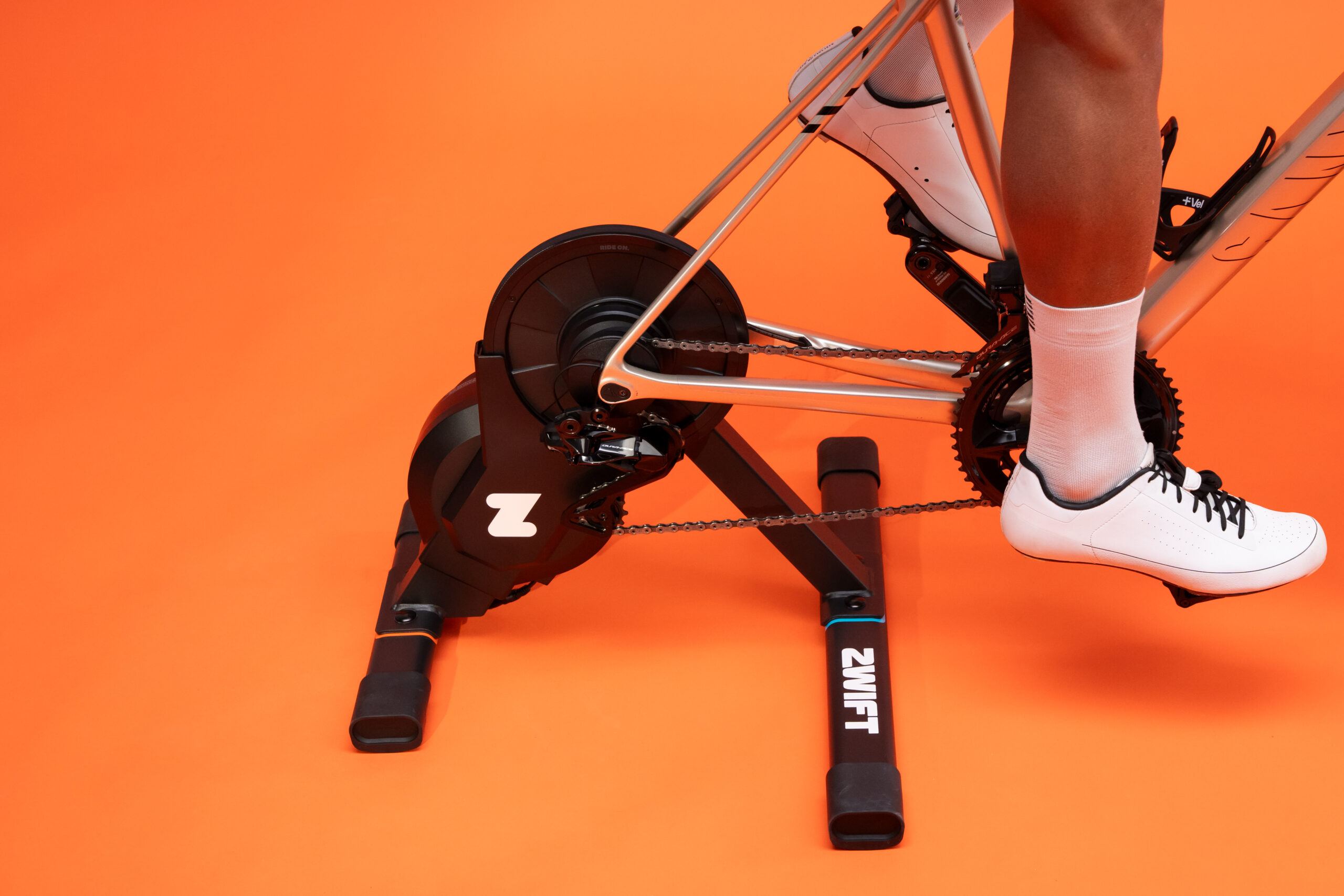
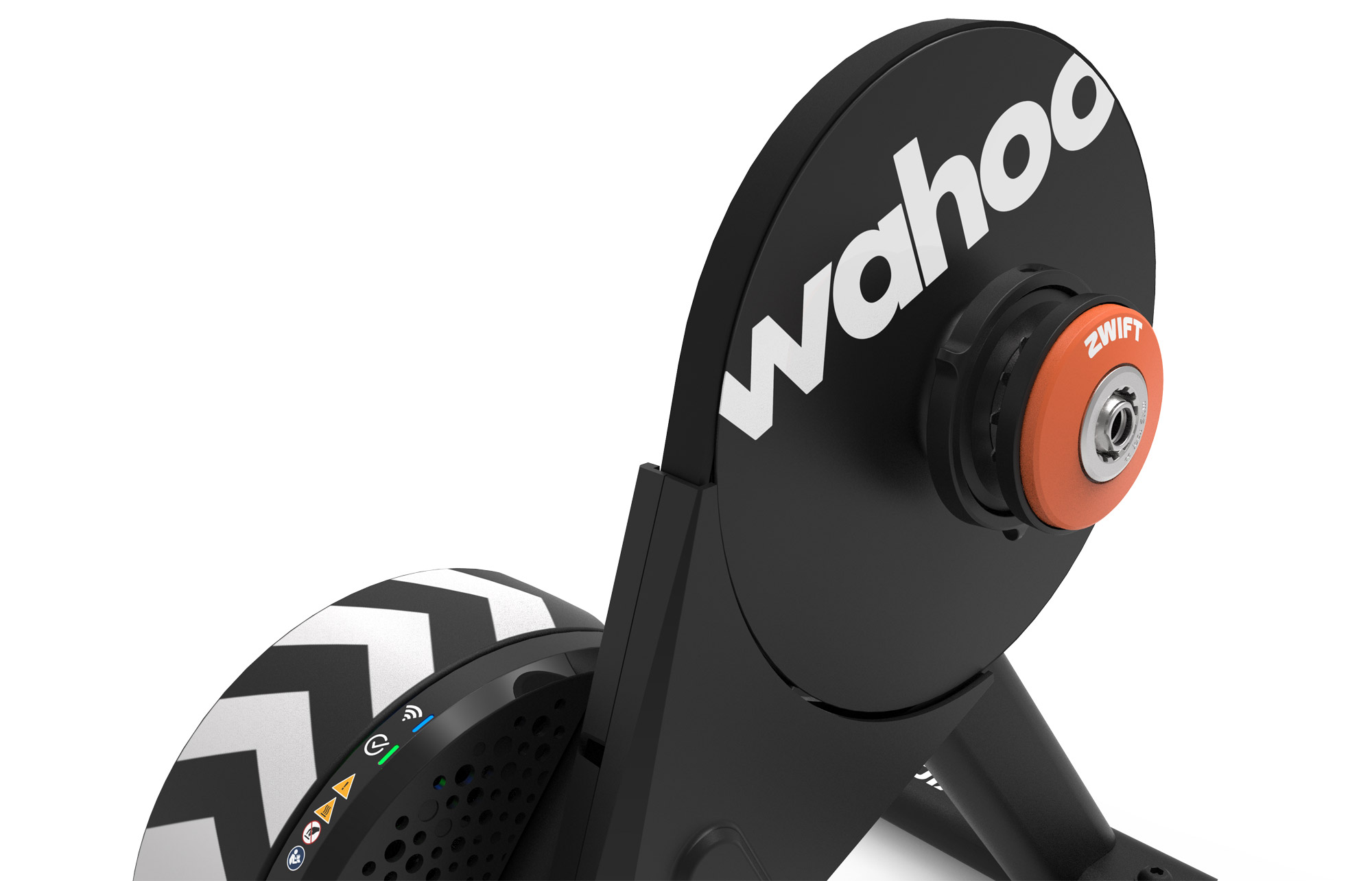
While you’ll need virtual shifting to use the Cog, you definitely do not need to have the Cog in order to use virtual shifting! Virtual shifting works just fine on a standard bike drivetrain with multiple front chainrings and a standard rear cassette.
The Cog was created by Zwift to simplify setups, as it eliminates the need to adjust your trainer’s cassette or fine-tune your bike’s shifting when placing your bike on the trainer. Just shift to a gear where your chain is lined up nicely on the Cog, and you’re ready to go!
If you have a trainer that supports virtual shifting, you can buy the Zwift Cog + Click Upgrade Kit ($49.99 US) and get the easy compatibility of the Cog with the simple shifting of the Click.
Gearing Details
By default, Zwift gives you 24 virtual gears ranging from a gear ratio of 0.75 to 5.49:
| Gear | Ratio |
| 1 | 0.75 |
| 2 | 0.87 |
| 3 | 0.99 |
| 4 | 1.11 |
| 5 | 1.23 |
| 6 | 1.38 |
| 7 | 1.53 |
| 8 | 1.68 |
| 9 | 1.86 |
| 10 | 2.04 |
| 11 | 2.22 |
| 12 | 2.40 |
| Gear | Ratio |
| 13 | 2.61 |
| 14 | 2.82 |
| 15 | 3.03 |
| 16 | 3.24 |
| 17 | 3.49 |
| 18 | 3.74 |
| 19 | 3.99 |
| 20 | 4.24 |
| 21 | 4.54 |
| 22 | 4.84 |
| 23 | 5.14 |
| 24 | 5.49 |
This is more than enough gears for any rider. By comparison, typical mid-compact road bike gearing with an 11-28 cassette offers a much narrower range of gear ratios (1.29 to 4.73), and some of those gears will overlap. In fact, using bike gear calculators, we can see that you’d have to run 30t and 60t chainrings paired with an 11-40 cassette to match the gear ratio range of Zwift’s virtual shifting!
Because Zwift’s virtual gears don’t overlap, the gear ratios can be spaced so the resistance change between each gear is never very large. For us, it feels just right.
Customizing Your Shifting
If you’d like your shifting to better mimic mechanical shifting on your IRL bike, there are shift style options available:
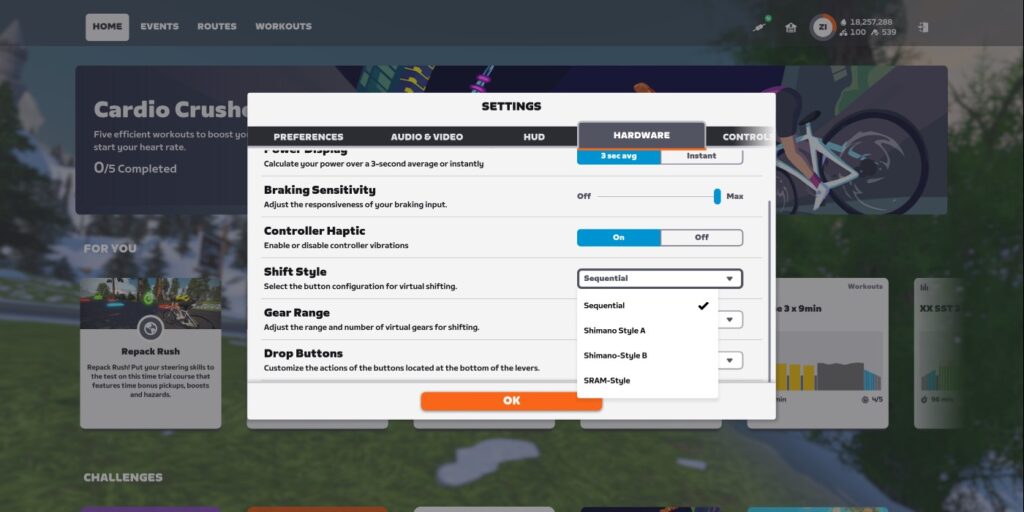
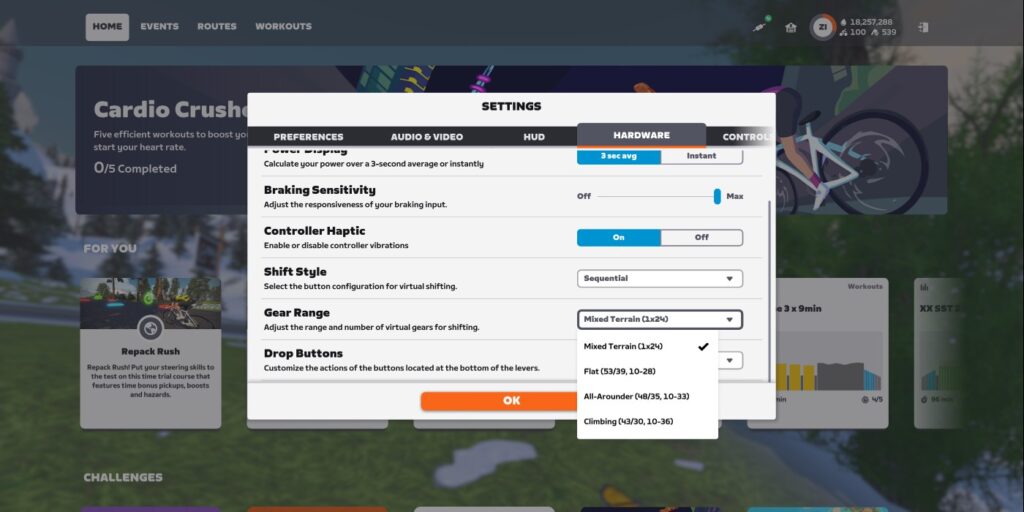
Under Settings>Hardware, there are two settings to modify your virtual shifting experience:
- Shift Style: choose how your shifting buttons behave. Options are Sequential, Shimano Style A, Shimano Style B, and SRAM Style. (Shimano styles are only available for Zwift Ride users, since you need two shift buttons on each controller.)
- Gear Range: change the gearing range of your virtual shifting. Options are Mixed Terrain (1×24), Flat (53/39, 10-28), All-Arounder (43-35, 10-33), and Climbing (43/30, 10-36).
You can also completely disable virtual shifting from this same settings screen.
Virtual Gearing Meets Physical Bikes
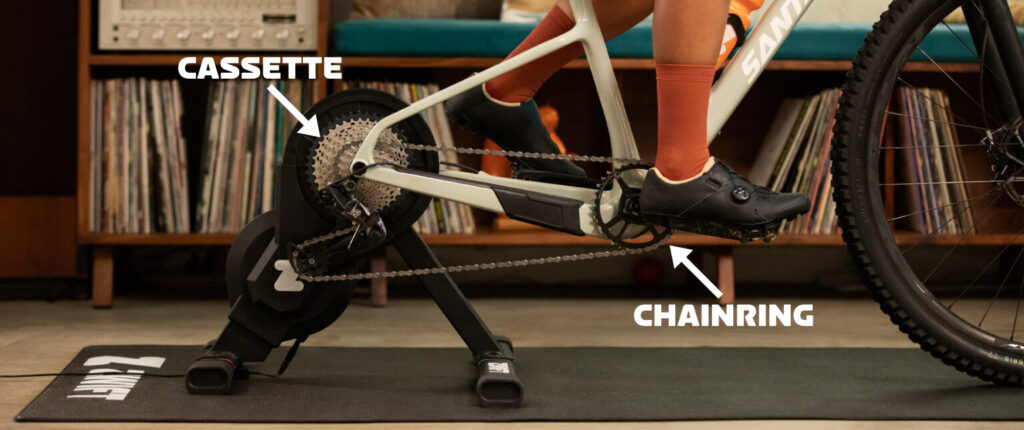
One of the beautiful things about virtual shifting is that it works with whatever physical gearing your bike has. Are you on a road bike with a wide range of gears? A mountain bike with a lower gear range? A city bike with a limited gear range? No matter. If you have virtual shifting enabled, Zwift automatically detects your physical gearing in the first few seconds of pedaling after you enter the game. It then sets up your virtual gearing to match the table above, using whatever physical gear you are currently in.
Because of this, you’ll want to be in the right physical gear before you start riding in game. Which gear should you be in? Zwift recommends the small ring in front, and a lower gear on your cassette (perhaps 3rd or 4th) which gives you a decently straight chain line.
(Of course, if you have the single-cog Zwift Cog, you don’t need to worry about which gear you’re in on the back.)
Personally, we prefer the inertial feel of the big ring in front, and 4th gear or thereabouts on the cassette. This feels more like riding on flat ground – where you don’t have to push across the top and bottom of the pedal stroke – vs climbing in the small ring. And it puts less of a strain on your trainer.
Try different physical gears and see which feels best to you. If you want to force Zwift to re-detect your physical gearing and thus recompute the feel of virtual shifting, you’ll need to do one of the following:
- Disconnect and reconnect your trainer
- Power cycle your trainer
- Restart the Zwift game
Questions or Comments?
Are you using Zwift’s virtual shifting? What do you think of it? Got questions? Share below!
